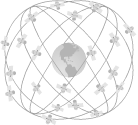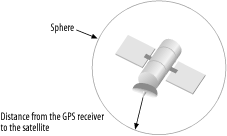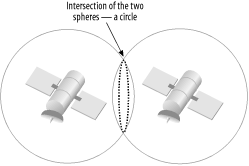| The Global Positioning System consists of 27 earth-orbiting satellites (of which 24 are operational and 3 are backups) circling the earth twice each day. These satellites are arranged in six orbital paths, as shown in Figure 9-1. Figure 9-1. Satellites circling the earth in six orbital paths  These satellites continuously emit coded positional and timing information using low-power radio waves at frequencies in the 1500 MHz range. GPS receivers on earth then pick up the signals and calculate the exact[1] positioning on earth. The orbits of the satellites are arranged in such a manner that at any one time, four satellites are visible. Thus, a GPS receiver is able to receive signals from these four satellites and, based on the various signals transmitted by them, derive positional information on earth. [1] Exact positioning is dependent on many factors, such as the type of receiver used and whether Selective Availability (see the sidebar Accuracy of GPS, later in this chapter, for more information) is turned on. In general, the precision of positioning can be anywhere from 5 meters to 100 meters.
So how does the GPS receiver calculate its position? It does so by measuring the distance between itself and the satellites. Signals emitted by the satellites will be received by the GPS receiver after a time lag, and based on the speed of light, the GPS receiver can calculate the distance from itself to the satellite. But getting the distance away from one satellite is not enough, since it tells you only that you are anywhere on the surface of the sphere (think in terms of three-dimensional space). Figure 9-2 shows that you can be anywhere on the sphere surrounding the satellite. Figure 9-2. A sphere containing all the possible positions  To pinpoint your exact location, GPS uses a technique call triangulation. It uses at least three satellites to pinpoint an exact location on earth. Figure 9-3 shows that if you have two satellites, then you can narrow down your location to the intersection of the two spheres. In this case, you can be anywhere on the dotted line (which is a circle). Figure 9-3. Intersection of two spheres forming a circle  This is not precise enough. With a third satellite, you can reduce the possibilities to two (see Figure 9-4). But one of these two points is in space, which is not likely the position you are in. Hence you can effectively derive your position from three satellites. Figure 9-4. Intersections of the circle (formed by the two intersecting spheres) with a third sphere   | Most GPS receivers use information from three or more satellites to increase the accuracy of the positional information. |
|
Accuracy of GPS GPS was originally developed in the 1980s by the U.S. Department of Defense for military use. Because it was designed primarily for the military, the U.S. Department of Defense introduced Selective Availability (SA) to degrade the signal accuracy and to encrypt sensitive information, so that civilian usage could be restricted. The satellites would deliberately broadcast wrong and randomly inaccurate signals, which would cause the precision of the GPS data to be within 100 meters. The accurate information could only be decoded by the military. Because of the great commercial potential of GPS, in May 2000, President Clinton announced that the U.S. would no longer degrade the accuracy of GPS. With SA turned off, the accuracy of the GPS data could be within 5 meters. In the second Gulf war against Iraq in 2003, the United States reportedly degraded the GPS system so that Iraq could not make use of GPS against U.S. forces. While this is good news for the military, it certainly affected all those who rely on GPS for their daily activities. So, if you arrived at the wrong destination using a GPS navigational system, now you know why! |
9.1.1 Uses of GPS The function of GPS is fairly straightforward with a GPS receiver, you can obtain your positional information in the form of longitude, latitude, and altitude. What is important is the way you use this information. Some useful applications of GPS are described next.
- Military use
-
As GPS was originally developed for military use, the U.S. Department of Defense is the main user of the technology. The use of GPS for guiding "smart" bombs has played an important role in recent wars, especially in the Persian Gulf.
- Location Based Services (LBS)
-
GPS has been increasingly deployed in the commercial scene. Location Based Services make use of the knowledge of your precise location to provide location-sensitive services. For example, you can use location-based services to give you a list of restaurants near your current location.
- Navigation services
-
GPS is popularly used for navigational purposes, such as driving and flying. A GPS-enabled PDA can help a driver to navigate unfamiliar cities. GPS is also widely used in the shipping industry as well as in airplane navigational systems. Courier companies such as UPS and FedEx make extensive use of GPS in their delivery infrastructures.
- Tracking
-
Using GPS to track the whereabouts of people or objects is rapidly gaining acceptance. This is useful in the medical sector where patients suffering from diseases such as Alzheimer's can wear a GPS watch, and when needed, press a panic button to reveal their exact location to their family members.
- Mapping
-
GPS is also popularly used in mapping software, allowing you to combine a GPS receiver with mapping software to display your current location. This is useful for travelers or explorers who need navigational aids.
9.1.2 A GPS Glossary Here are some GPS terms that you will encounter when you use GPS and GPS software:
- Waypoint
-
A location that you store in your GPS system (as coordinates). Examples of waypoints are a hiking location, camping ground, church, or any places of interest to a GPS user. You normally add a waypoint to your GPS before you start your traveling. You can also add one during your travel when you locate a place of interest.
- Route
-
A collection of waypoints representing the path that you would like to take.
- Latitude, Longitude, and Altitude
-
The coordinates of a specific location on earth. These three pieces of information together define a point in the three-dimensional space.
- Bearing
-
The direction you are aiming for.
- Heading
-
The actual direction you are traveling towards. It is not the same as bearing. Bearing is your desired direction, but you may not be heading towards the desired direction due to factors such as obstacles (e.g., water, fences, and mountains). Therefore, you have to momentarily head in another direction in a bid to get to your destination.
- Fix
-
A location returned by the GPS receiver after processing the readings of at least three satellites.
- TTFF (Time to First Fix)
-
The least amount of time required to get a fix by the minimum number of satellites required for triangulation. Normally it takes a few minutes before you can get a fix.
- NMEA (National Marine Electronics Association)
-
The NMEA-0183 standard has been universally adopted by GPS manufacturers and virtually every GPS product for exchanging navigational information between devices. NMEA-0183 defines a "sentence" format (using printable ASCII text) describing navigational information.
- 8/12 channels receiver
-
An 8-channel receiver uses 8 channels to access 8 different satellites at any one time. A 12-channel receiver can access 12 satellites at once.
- Selective Availability (SA)
-
The degrading of GPS signals and the encryption of GPS data for non-military use. See Accuracy of GPS earlier in this chapter for more information on SA.
- CEP, RMS, and 2D RMS
-
Circular Error Probable (CEP), RMS (Root Mean Square), and 2D RMS are all measures of the accuracy of a GPS receiver. CEP represents the radius of a circle containing 50 percent of the GPS readings. RMS represents the radius of a circle containing 68 percent of the GPS readings. 2D RMS represents the radius of a circle containing 98 percent of the GPS readings. If 3 GPS receivers each claims to have 2m CEP, 2m RMS and 2m 2D RMS respectively, then the third one is the most accurate, since it has readings accurate to within a 2-meter radius 98 percent of the time.
|




